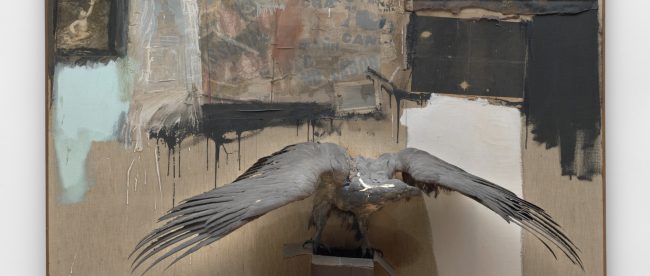The Worthless $65 Million Masterpiece That Cost $29 Million


The work of art pictured above, called Canyon, was created by American painter Robert Rauschenberg in 1959. It’s now in the collection of the Museum of Modern Art; here’s the listing on their website. Rauschenberg’s style of art — called “Combines” — were, in the words of MoMA, “hybrid works incorporating painting, collage, and found objects.” In the case of Canyon, it’s made of the following:
Oil, pencil, paper, metal, photograph, fabric, wood, canvas, buttons, mirror, taxidermied eagle, cardboard, pillow, paint tube and other materials
Pretty standard stuff — oil, paper, metal, and … taxidermied eagle? Okay, that’s a bit different. And it created a big problem.
When Rauschenberg created Canyon in 1959, the stuffed bald eagle wasn’t a big deal — he, again per MoMA, found it “in a pile of discarded belongings in the hallway of the Carnegie Hall studio building.” (Happens all the time.) But three years later, Congress amended the Bald and Golden Eagle Protection Act, a law originally designed to prohibit the owning, selling, or killing such birds. The 1962 amendment expanded the prohibition to include feathers and body parts (with an exception for Native American bonnets) — and therefore, also prohibited the use of that taxidermied eagle in the work of art.
Before that amendment went through — or perhaps before anyone noticed that the law and the eagle didn’t work well together — an art dealer named Ileana Sonnabend acquired the Combine. When Sonnabend died in 2008, her heirs inherited it — and the IRS wanted a cut of the inheritance. The taxing authority appraised the work at $65 million and demanded a payment of $29.2 million. Normally, that wouldn’t be a problem — you’d just sell the piece, collect your $65 million or so, and give the IRS its cut. But because of the Bald and Golden Eagle Protection Act, that couldn’t happen. The U.S. Fish and Wildlife Service, citing the law, notified Sonnabend’s heirs that they couldn’t sell it without being subject to potential jail time. The absurd result: a nearly $30 million tax bill for inheriting something with a fair market value of zero.
At first, it looked like the IRS was going to hold fast to its position — the agency actually upped the tax bill to $40.9 million, issuing penalties because they believed the heirs had intentionally understated the work’s value. But once the press picked up on the ridiculousness — the New York Times, for example, ran the story on the front page in July of 2012 — the IRS capitulated. Four years after Sonnabend died, the agency agreed to waive the tax bill if her heirs donated the work to a cultural institution; they gave it to MoMA later that year.
Bonus fact: The Bald and Golden Eagle Protection Act doesn’t apply to people living in Mongolia, and a group of people known as burkitshi couldn’t be happier. The burkitshi are nomadic hunters who capture eagles as a young age — typically when the birds are only about four years old. But, as the New Yorker explains, the eagles aren’t the prey — they’re the hunting rifles. The burkitshi, or eagle-hunter, domesticate and train the birds to hit foxes and other animals on their behalf. (Here’s an incredible video by the BBC of an eagle-hunter and eagle in action.) The birds, which often live to about the age of 30, are released back into the wild after ten or so years of service.
From the Archives: How to Pay Yourself $2.1 Million in Taxes: And how to get caught.
